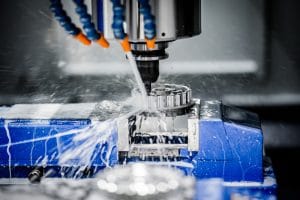Get to Know CNC Machining Basics

CNC machining is a process of cutting and shaping materials using computer-controlled tools. It’s a subtractive manufacturing process, which means that it starts with a block of material and removes parts of it to create the desired shape. CNC machining is used to create parts and products from a variety of materials, including metals, plastics, and composites. The process can be used to create both small and large parts, with a high degree of accuracy. In this blog post, we’ll explore the basics of CNC machining and how it’s used to create parts and products. We’ll also touch on the benefits of CNC machining and some of the challenges associated with the process.
What is CNC Machining?
CNC machining is a process that uses computer-controlled machine tools to create parts from a range of materials. The process can be used to create both small and large parts, and can be adapted to create a wide variety of shapes and features.
CNC machining is a versatile manufacturing process that can be used to create a wide variety of parts and products. The process is well suited for creating small, intricate parts, as well as large, complex parts. It can also be used to create a wide variety of shapes and features, making it an ideal choice for many different applications.
The History of CNC Machining
CNC machining is a process that uses computer-controlled tools to remove material from a workpiece. The history of CNC machining can be traced back to the early 1950s, when the first NC (numerical control) machine was developed.
Since then, CNC machining has evolved significantly, and today it is one of the most widely used manufacturing processes in the world. In fact, it is estimated that more than 80% of all manufactured products involve some form of CNC machining.
There are many different types of CNC machines, each with its own unique capabilities. However, all CNC machines share a common goal: to produce high-quality parts with precise tolerances.
CNC machining has revolutionized the manufacturing industry, and it shows no signs of slowing down. As technology continues to evolve, so too will the capabilities of CNC machines.
How Does CNC Machining Work?
CNC machining is a computer-controlled manufacturing process that enables the production of precision parts from a variety of materials. The process involves the use of rotating cutting tools to remove material from the workpiece, which is mounted on a movable platform.
The cutting tools are controlled by a computer program that tells them how deep to cut and what direction to move in. The program also controls the speed at which the cutting tools rotate and the feed rate, which is the speed at which the workpiece moves through the machine.
CNC machining can be used to produce parts with complex shapes and tight tolerances. It is an efficient way to produce large quantities of parts quickly and accurately.
What Materials Can Be Machined Using CNC?
Materials that can be machined using CNC technology include metals (steel, aluminum, brass), plastics (acrylic, polycarbonate), and composites (fiberglass, carbon fiber). In terms of specific materials that are commonly machined using CNC technology, aluminum is a popular choice because it is strong yet lightweight. Other popular choices include steel and brass, which are both durable and have a high resistance to wear and tear.
What Are the Advantages of CNC Machining?
CNC machining offers a number of advantages over traditional machining methods. Perhaps the most significant advantage is increased accuracy. CNC machines can produce parts that are much more accurate than those produced by hand or by less precise machine tools.
Another advantage of CNC machining is that it is generally faster than other methods of machining. This is because the process can be automated, and the machines themselves are typically very fast.
CNC machining also offers greater flexibility than other methods. This is because CNC machines can be programmed to produce a wide variety of shapes and sizes of parts. They can also be programmed to produce multiple parts at the same time, which increases efficiency. Additionally, CNC machines can be used to create parts with very complex shapes that would be difficult or impossible to create using other methods.
What Are the Disadvantages of CNC Machining?
There are several disadvantages of CNC machining when compared to other manufacturing processes. One disadvantage is the high initial investment cost for the CNC machine and associated software. Another disadvantage is the skilled labor required to operate and program the machine. Yet another potential disadvantage is the limited flexibility of CNC machining, as it can only produce parts that are designed specifically for the CNC machine. Finally, CNC machining can generate large amounts of waste material, which can be costly to dispose of properly.
Conclusion
CNC machining is a versatile manufacturing process that can produce parts of all shapes and sizes. With the right CNC machine, you can create just about anything you need. If you’re thinking about investing in a CNC machine for your business, be sure to do your research so that you choose the right one for your needs. And if you need help getting started with CNC machining, our team at XYZ Machinery is always here to help.


